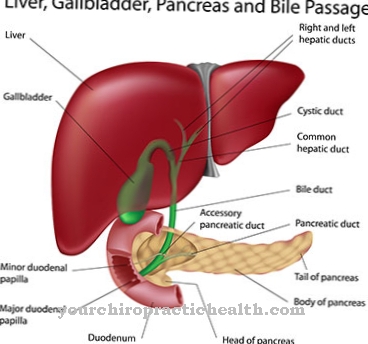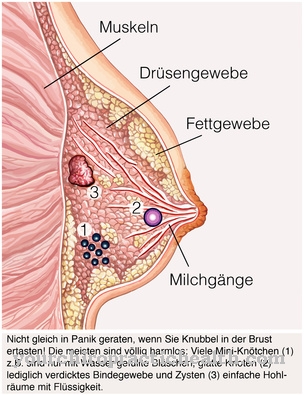A neurosis or neurotic disorder is a collective name for many different mental and emotional disorders. Usually there are no physical causes. Various anxiety disorders often accompany the neurosis. A neurosis must be separated from its counterpart, the psychosis. The most common neurotic disorders are anxiety disorder, obsessive-compulsive disorder, and hypochondria.
What is a neurosis?

© timonina - stock.adobe.com
The designation neurosis is no longer used in the diagnostic manuals used today: The ICD-10 of the WHO categorized under Neurotic disorders various mental illnesses with no physical cause. Phobic disorders, anxiety and obsessive-compulsive disorders, stress and adjustment disorders, dissociative disorders, multiple personality disorders, somatoform and "other neurotic disorders" are summarized here under Chapter F 4.
Historically, William Cullen defined neurosis in 1776 as a nerve-related functional disease with no organic cause. In the tradition of psychoanalysis, Sigmund Freud developed the concept of a mild psychological disorder that arose from an emotional conflict. Freud related this conflict to suppressed fears or sexual problems.
causes
Behavioral therapy sees the cause of one neurosis in a conditioned (learned) mismatch. The triggers here are so-called stressors, which have a traumatizing influence on the organism. Today, a neurosis is usually understood to be a pathological disturbance of the processing of experiences: The failure to process a conflict or the dysfunctional perception of a triggering situation leads to emotional, psychosocial or physical symptoms.
An organic participation in the development of a neurosis is no longer excluded: For example, genetic dispositions are described as contributing to the cause in "vulnerability-stress hypotheses". An increased willingness to fear or an exaggerated fear reaction to neutral stimuli shows up as a connecting element of the individual disorders despite their different symptoms.
Statistically, neurotic disorders make up a large part of mental illness. In the case of somatoform disorders in particular, the female gender in the middle to upper social class is overrepresented, although this accumulation could also be due to the fact that women visit a doctor more often and are more easily recorded statistically.
Symptoms, ailments & signs
Depending on the type and severity, a neurosis can cause different symptoms. With panic disorder, panic attacks occur suddenly, which are expressed by strong palpitations, shortness of breath, dizziness, chest pain, tremors, sweating, dry mouth and fear of death. The seizures do not seem to have a direct trigger and usually last only a few minutes.
If only physical symptoms that affect the heart are increasingly perceived (increased pulse, chest pain, shortness of breath), the doctor speaks of a heart neurosis. A phobia manifests itself as an unfounded fear of certain situations, objects, or animals, while generalized anxiety disorder is characterized by a long-lasting, diffuse feeling of fear without a specific trigger. Symptoms of this can be constant internal tension, feelings of oppression, dry mouth, dizziness and sleep disorders associated with tremors and restlessness.
A sign of OCD can be an uncontrollable urge to do something like washing your hands repeatedly for no apparent reason. Obsessive-compulsive thoughts or the compulsive impulse to hurt yourself or others can also lead to an obsessive-compulsive disorder.
Hypochondria manifests itself through an increased awareness of one's own body, even harmless deviations from the norm are perceived as serious disorders. Body functions are permanently checked; even an inconspicuous examination result does not dissuade the hypochondriac from the belief that he is seriously ill.
Course of disease
Referring to the course of a neurosis As with many mental disorders, the rule of one third applies: one third of those affected are able to lead a normal life largely unaffected by the neurotic abnormality, one third continuously experience phases with severe symptoms that require treatment, one third is so impaired by the disease that only a social niche existence is possible. This last third is resistant to treatment.
Neuroses manifest themselves mainly between the ages of 20 and 50 with a peak in the third decade. Neurotic depression, known today as dysthymia, seems to be the most common neurosis at around 5%. Even in childhood and adolescence, neuroses can appear as early or bridging symptoms, some of which can persist into adulthood: wetting, defecation, eating disorders, mentally-related heart and breathing problems, anxiety, social insecurity, disturbed attachment behavior, compulsions, phobias, stuttering , Nail biting, aggressiveness, truancy, etc.
Complications
The complications associated with a neurosis depend on the type of neurosis. Neuroses that intervene in the environment of third parties (delusional order, sociophobic disorders, paranoid disorders, hysteria) can lead to social isolation and a negative self-image in those affected. Since they are consistently aware of their neurosis, limitation and isolation can intensify negative feelings.
Neuroses that are only aimed at the person concerned (compulsory washing, compulsory order with one's own objects) at best have a time-wasting effect, but can also lead to skin irritation, physical overload and the like.
Neuroses have great potential to permanently burden those affected. The constant psychological stress leads to the same effects as constant stress. Depressive tendencies, heart problems, decreased self-esteem and other symptoms follow and may require treatment.
The neuroses, which are only noticeable physically, represent a special case. Heart neuroses, intestinal neuroses or gastric neuroses can represent a permanent burden for the body and in the worst case lead to pain or persistent functional disorders of the affected organs.
You can find your medication here
➔ Medicines to calm down and strengthen nervesWhen should you go to the doctor?
Neuroses are mental illnesses that have to be taken seriously and can lead to those affected putting themselves and other people at risk. For the layman it is difficult to recognize neuroses as such; However, every outsider notices from the behavior of an affected person that he is mentally not well. Neuroses can be temporary or permanent conditions - regardless of the form in which they occur, they always require the fastest possible psychological help. Often people with neurosis will not turn to a doctor themselves, so the relatives are challenged.
If there is reason to believe that a neurotic patient could injure or endanger himself or others, or even intend to commit suicide, there is the option of forcibly admitting him to a psychiatric institution. This is for his own protection and he will only be released when he is no longer a threat. Affected people who have previously refused any help can often only be helped in this way and remain in treatment after such a drastic experience. Temporary neuroses, such as in the case of a postpartum disorder, are now so well known that potentially endangered patients can be informed about this possibility in advance.
Treatment & Therapy
Depending on the specific clinical picture one neurosis and theoretical orientation, different therapy methods have established themselves: While psychoanalysis tries to fathom early childhood conflicts, modern behavioral therapy focuses on learning coping strategies that allow appropriate behavior (and thus feelings) in acute conflict situations.
Most often, especially in the case of obsessive-compulsive disorder and anxiety, a combination of psychopharmacological and behavioral treatment is used. Phobias respond very well to so-called exposure methods of behavioral therapy, whereby the person affected is exposed to the confrontation with the phobic stimulus, which can take place in real life (in vivo) or in imagination (in sensu). Obsessive-compulsive disorder is very difficult to treat despite supportive medication.
Outlook & forecast
The prognosis for a neurosis depends on the type and severity of the disease. When it comes to organic neuroses, i.e. functional diseases without a recognizable trigger or reason, the problem can sometimes be remedied with simple interventions. After that, at best, there are no more complaints at all, or the complaints are noticeably reduced and the person's quality of life can be improved.
Psychological neuroses mostly fall into the field of personality disorder or learned maladjustment and can be treated with appropriate psychotherapy and, if necessary, with the use of medication. If the neurotic disease is a maladjustment, it can be assumed that the person concerned has adapted better to certain situations in the past, or at least that this normal reaction is in him. Psychotherapy can help to steer the learned misconduct back into healthy and socially desirable paths.
After the treatment, at best, those affected no longer notice anything of the neurosis that was there. Personality disorders, on the other hand, often persist even with treatment, although those affected can learn to deal with them healthier through various therapeutic approaches. Medicines can also help to cope better with the consequences of such a disorder and to reduce the suffering of those affected in the long term. For a good prognosis, however, it is important that those affected voluntarily participate in the therapy.
Aftercare
In the case of a neurosis, consistent follow-up care is often crucial, especially in the phase after the end of therapy, if the aim is to stabilize the success of the treatment in the long term. Follow-up care is usually coordinated with the treating psychologist or psychotherapist. If questions or problems arise, the patient can also clarify them in a new session as part of the follow-up care.
The follow-up care is optimally tailored exactly to what form of neurosis the patient has and in what form it has shown itself. If, for example, it is an anxiety neurosis that has been treated as part of behavioral therapy, it is usually also important in aftercare that the patient repeatedly exercises the newly learned behavioral patterns on their own and consistently integrates them into their everyday lives.
A self-help group is often the ideal companion in this context. Discussing problems with like-minded people is often particularly helpful and exchanging experiences can help overcome crises and offer valuable tips. Relaxation is also important for neurosis patients and thus an important component in the follow-up care of this disease.
Relaxation methods such as progressive muscle relaxation and autogenic training are ideally learned under supervision in a course and then used independently at home. Attending yoga classes also helps to relax.
You can do that yourself
Since the term “neurosis” can be interpreted differently, the possibilities for self-help are also broad. In many neurotic disorders, relaxation techniques and mindfulness have a positive effect, including a. for anxiety disorders, obsessive-compulsive disorders, various personality disorders and somatoform disorders. Scientifically proven deep relaxation offers, for example, autogenic training or progressive muscle relaxation. Both procedures can help reduce symptoms in the long term.
There are several ways to learn a relaxation process. If those affected want to teach themselves deep relaxation, they can fall back on books or well-founded instructions from the Internet. Audio recordings with instructions can also help.
Another option is to take a relaxation class given by a qualified instructor. In Germany, the statutory health insurances promote relaxation as primary prevention. The cost of a relaxation course can therefore be reimbursed by the health insurance company. The prerequisite is that the course instructor has the appropriate cash register approval. A diagnosis does not have to be available. Relaxation should also be used regularly after the course has ended so that it can be effective.
People with personality disorders can benefit from good self-reflection in everyday life. In doing so, they apply what they have learned in therapy. Exchanging ideas with other people affected can be helpful; However, care must be taken that there is no competition in the self-help group.
























.jpg)



